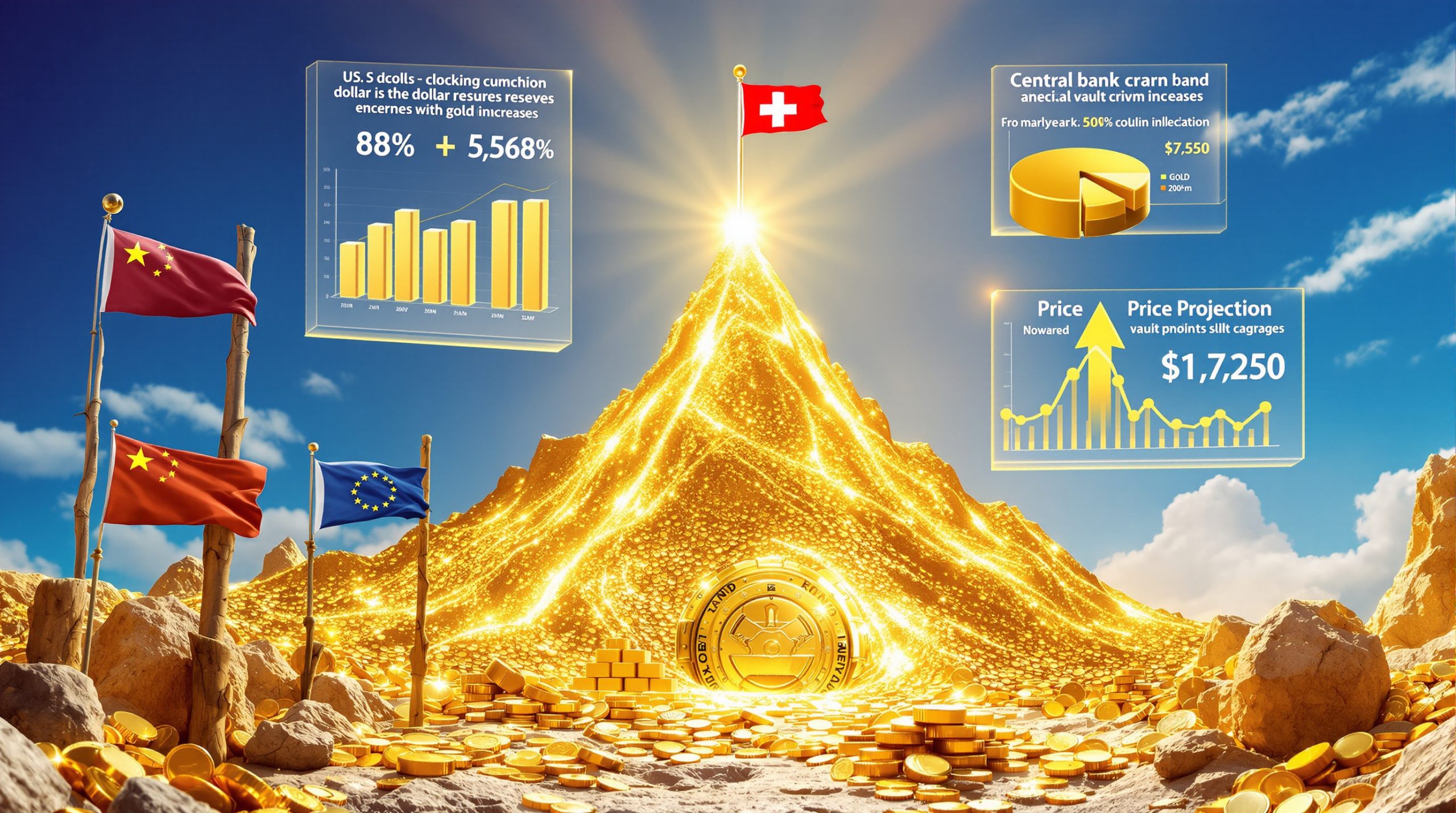Understanding Market Rotation Fundamentals
Market rotation represents a fundamental shift in investor behavior where capital systematically moves between different asset classes, sectors, and investment strategies. This phenomenon extends far beyond typical sector rotation within equity markets, describing massive capital flows from entire asset categories into alternative investment vehicles.
Super capital rotation distinguishes itself through scale and duration. When investors collectively reassess risk due to economic uncertainty, monetary policy changes, or extreme valuation concerns, money doesn't simply rotate between technology and healthcare stocks. Instead, entire asset classes experience prolonged outflows whilst others receive sustained inflows over periods spanning multiple years. Understanding these US economy risks becomes crucial for investors navigating such transitions.
Investment professionals recognise several defining characteristics of super capital rotation events:
• Massive equity outflows: Growth and technology stocks experience sustained selling pressure
• Hard asset accumulation: Increased allocation to precious metals, commodities, and tangible assets
• Value sector preference: Capital flows toward financials, energy, and industrial companies
• Extended duration: Trends persist for years rather than quarters
• Policy coincidence: Often aligns with major economic transitions or monetary policy shifts
The mechanics underlying these rotations involve institutional and retail investors simultaneously recognising fundamental imbalances in market valuations. Unlike cyclical sector rotation driven by business cycle dynamics, super capital rotation reflects deeper structural concerns about currency stability, debt sustainability, and asset bubble formation.
Historical Context: Learning from Past Rotations
Three major super capital rotation periods provide instructive precedents for understanding current market dynamics. Each episode shared common elements whilst exhibiting unique characteristics shaped by their specific economic environments.
The 1930s Depression Era Rotation
The most dramatic historical example occurred during the Great Depression following the collapse of the gold standard system. According to Federal Reserve historical data, when President Franklin D. Roosevelt's Executive Order 6102 required citizens to surrender gold coins and certificates in April 1933, the subsequent devaluation created unprecedented wealth transfers.
Gold prices increased approximately 69% from the fixed $20.67 per ounce to $35 per ounce by January 1934, contradicting some inflated historical claims. However, equity markets experienced devastation, with the S&P Composite Index declining approximately 86% from its September 1929 peak to July 1932 trough levels.
| Period | Asset Class | Performance | Duration |
|---|---|---|---|
| 1929-1932 | S&P Composite | -86% decline | 3 years |
| 1933-1934 | Gold (post-devaluation) | +69% appreciation | 1 year |
| 1929-1942 | Equity recovery period | 13 years to new highs | 13 years |
The 1970s Stagflation Revolution
The breakdown of the Bretton Woods system in August 1971 created the most comprehensive super capital rotation in modern financial history. FRED Economic Data confirms gold's remarkable appreciation from approximately $40-45 per ounce in 1971 to $850 per ounce in January 1980, representing an 1,790% increase over nine years.
Silver demonstrated even more dramatic performance, rising from approximately $1.29 per ounce in 1971 to $50 per ounce during the Hunt brothers' market manipulation attempt in March 1980. This 3,775% increase exceeded gold's appreciation, illustrating silver's potential volatility during monetary crises. Furthermore, this period highlighted the importance of considering gold-silver ratio insights when analysing precious metals markets.
Equity markets suffered prolonged stagnation when measured in real terms. While the S&P 500 generated nominal returns averaging 5.9% annually during the 1970s, inflation averaging 7.1% annually resulted in negative real returns throughout the decade.
Early 2000s Technology Bubble Aftermath
The dot-com crash initiated a more moderate but significant rotation favouring hard assets over growth stocks. The S&P 500 declined 47% from its March 2000 peak to October 2002 trough, whilst precious metals began their secular bull market.
Russell Index data confirms value stocks dramatically outperformed growth stocks during 2000-2009:
• Russell 1000 Value Index: +2.7% annualised returns
• Russell 1000 Growth Index: -2.4% annualised returns
This rotation coincided with the emergence of real estate as an alternative asset class, creating the conditions for the subsequent housing bubble and 2008 financial crisis.
Current Market Indicators and Warning Signs
Contemporary market conditions exhibit several characteristics reminiscent of historical super capital rotation periods. Multiple technical and fundamental indicators suggest potential regime change, though timing remains uncertain.
Valuation Extremes and Concentration Risk
Technology sector valuations have reached historically elevated levels, with the largest technology companies representing unprecedented market capitalisation concentrations. The "Magnificent 7" technology stocks (Microsoft, Apple, Nvidia, Google, Amazon, Meta, Tesla) collectively represented approximately 30-35% of S&P 500 market capitalisation as of mid-2024, creating systemic concentration risk.
Monetary Policy Environment
Central bank balance sheet expansions following the 2008 financial crisis and 2020 pandemic response have created concerns about currency debasement. M2 money supply growth, whilst moderating from peak pandemic levels, remains elevated relative to historical norms. Comprehensive gold price analysis reveals how these monetary conditions influence precious metals markets.
Multi-Asset Bear Market in Gold Terms
Market analysts tracking asset performance relative to gold prices identify concerning patterns across multiple categories. When denominated in gold rather than dollars, numerous asset classes including money supply metrics, major stock indices, and commodity price indices show declining relative performance.
According to technical analysts at Northstar Bad Charts, their matrix of indicators shows almost everything in bear markets when priced in gold, including money supply (M2), the dollar index, CPI, PPI, major stock indexes, and most S&P sectors.
Institutional Positioning Shifts
Hedge fund positioning data suggests growing scepticism toward technology growth stocks, with net long positions declining at the fastest pace in recent years. Simultaneously, sovereign wealth funds and pension systems have increased allocations toward commodity-linked investments and inflation-protected assets.
The Silver Catalyst: Why This Metal Could Trigger the Rotation
Silver's unique dual nature as both industrial and monetary metal positions it as a critical catalyst for super capital rotation events. Unlike gold's primarily monetary function, silver's industrial demand creates supply-demand dynamics that can accelerate rotation patterns.
Technical Breakout Potential
Silver approaches a critical technical resistance zone around $55-56 per ounce, according to long-term chart analysis. Market technicians identify this level as representing a multi-decade cup-and-handle pattern formation spanning approximately 45-50 years.
A decisive breakout above this resistance could trigger what analysts describe as a "spike move" toward $75-100+ per ounce in a compressed timeframe. However, such moves historically experience brutal corrections of 35-50%, particularly when coinciding with equity market stress and forced liquidations. These dynamics form part of broader silver market squeeze scenarios affecting global finance.
Industrial Demand Fundamentals
The Silver Institute's 2024 World Silver Survey confirms growing industrial consumption across multiple sectors:
| Application | Demand Share | Annual Consumption |
|---|---|---|
| Solar photovoltaic | 13% | ~3,600 tonnes |
| Electronics/electrical | 21% | ~5,700 tonnes |
| Automotive (including EVs) | Growing | 20-50 grams per vehicle |
| 5G infrastructure | Emerging | Proprietary data |
Electric vehicle adoption requires silver in electrical contacts, switches, and conductive adhesives, whilst 5G infrastructure deployment demands silver in antennas and circuitry components. Solar panel manufacturing represents the fastest-growing industrial silver application.
Monetary Demand Catalysts
Central banks have quietly begun accumulating silver reserves, marking a significant shift from purely gold-focused policies. Russia, India, and Saudi Arabia have initiated silver purchasing programs, signalling recognition of silver's monetary properties alongside its industrial applications.
Supply-Demand Dynamics
Silver markets have experienced five consecutive years of supply deficits, with industrial demand growth exceeding mine production increases. This structural imbalance creates conditions favourable for price volatility during periods of increased monetary demand.
Asset Class Performance During Rotation Events
Historical analysis reveals consistent patterns of asset class performance during major rotation events, providing insight for portfolio positioning strategies. Understanding these patterns becomes essential for implementing effective diversification investing strategies during turbulent periods.
Outperforming Categories
Precious metals consistently deliver exceptional returns during super capital rotation periods:
| Asset Category | Typical Performance Range | Primary Drivers |
|---|---|---|
| Gold | 200-800% gains | Monetary debasement, safe haven demand |
| Silver | 300-3,700% gains | Dual monetary/industrial demand |
| Energy equities | 100-300% returns | Supply constraints, inflation hedge |
| Basic materials | 150-400% appreciation | Commodity super-cycle dynamics |
Energy sector performance benefits from supply constraints and inflation hedging characteristics. Companies with strong balance sheets, low debt levels, and dividend-paying capacity typically outperform during rotation periods.
Basic materials and mining equities experience appreciation driven by commodity price increases and currency debasement concerns. Companies controlling high-quality reserves with low-cost production profiles demonstrate particular strength.
Underperforming Assets
Growth-oriented investments consistently underperform during super capital rotation:
• High-valuation technology stocks: Particularly vulnerable due to growth premium compression
• Speculative investments: Meme stocks and unprofitable companies experience severe declines
• Long-duration bonds: Suffer during inflationary rotation periods
• Highly leveraged companies: Vulnerable to rising interest rates and economic uncertainty
Defensive Positioning
International diversification becomes crucial during rotation events, as currency debasement often affects domestic assets disproportionately. Commodity-linked investments and inflation-protected securities provide portfolio stability.
Investment Strategy Implications
Strategic positioning for super capital rotation requires balancing wealth preservation against growth opportunities whilst managing heightened volatility.
Portfolio Rebalancing Framework
Gradual reduction of overvalued growth sector exposure allows investors to capture remaining upside whilst reducing concentration risk. Increased allocation to hard assets and commodities provides inflation protection and currency hedge characteristics.
Implementation Methodology
Dollar-cost averaging into preferred asset classes helps manage timing uncertainty inherent in rotation events. Avoiding attempts to precisely time market turns reduces execution risk whilst maintaining systematic exposure to favoured themes. For instance, insights from capital rotation opportunities can guide strategic positioning decisions.
Focus on fundamental value rather than momentum prevents chasing overvalued assets during rotation periods. Companies with strong balance sheets, sustainable business models, and reasonable valuations typically demonstrate resilience during market transitions.
Risk Management Principles
Diversification across multiple asset classes and geographic regions reduces concentration risk whilst maintaining exposure to rotation beneficiaries. Regular portfolio review and rebalancing ensures alignment with changing market conditions.
Maintaining emergency liquidity for personal needs prevents forced selling during market stress. Adequate cash reserves also provide flexibility to capitalise on opportunities during rotation-induced volatility.
Sector-Specific Opportunities and Risks
Different economic sectors exhibit varying performance characteristics during super capital rotation events, creating specific investment opportunities and risks.
Energy Sector Dynamics
The energy transition paradox creates unique opportunities as traditional energy companies benefit from supply constraints whilst renewable energy infrastructure requires significant commodity inputs. Oil and gas companies with strong balance sheets and sustainable dividend policies may outperform during rotation periods.
Financial Services Positioning
Banks and insurance companies typically benefit from rising interest rate environments through improved net interest margins and investment income. However, credit quality becomes increasingly important as economic conditions potentially deteriorate during rotation stress periods.
Regional banks with strong deposit bases and conservative lending practices often outperform money centre banks during rotation events. Insurance companies with substantial investment portfolios benefit from higher yields on new investments.
Materials and Mining Excellence
Base metals, precious metals, and agricultural commodity producers often deliver exceptional returns during currency debasement periods. Companies controlling low-cost production assets with long-lived reserves demonstrate particular strength.
Mining companies with strong balance sheets, experienced management teams, and diversified geographic exposure typically outperform single-asset producers during volatile rotation periods.
Technology Sector Challenges
High-valuation technology companies face multiple headwinds including reduced growth expectations, increased competition, and potential regulatory pressures. However, established technology companies generating substantial cash flows with reasonable valuations may prove more resilient.
Global Economic Implications
Super capital rotation events typically coincide with significant economic transitions extending beyond financial market performance into international trade, currency markets, and policy responses. Furthermore, understanding these broader implications helps investors appreciate the interconnected nature of global markets during transition periods.
Currency Market Impacts
Dollar strength potentially faces challenges as rotation into hard assets reduces demand for dollar-denominated financial assets. Emerging market currencies may benefit from commodity price increases, particularly for resource-rich economies.
Central bank gold and silver purchases could accelerate during rotation periods as monetary authorities seek to diversify reserve holdings away from pure fiat currency systems.
International Trade Effects
Commodity-exporting nations typically benefit from rotation-driven price increases in raw materials and energy products. Manufacturing costs may increase due to raw material price inflation, potentially reshaping global supply chain dynamics. Additionally, discussions around super capital cycle implications highlight how these changes affect international trade patterns.
Countries with substantial agricultural and mineral resources often experience improved terms of trade during rotation periods, whilst heavily import-dependent economies face challenges from rising commodity costs.
Policy Response Considerations
Central banks may face difficult choices between supporting financial markets through monetary accommodation and controlling inflation through restrictive policies. Government fiscal policies could shift toward infrastructure spending and resource security initiatives.
International cooperation on monetary policy may become more challenging as different economies experience varying rotation impacts. Coordination mechanisms established during previous crises may require adaptation to rotation-specific challenges.
Preparation Strategies for Individual Investors
Retail investors require specific preparation strategies addressing education, implementation, and psychological readiness for potential market rotation.
Education and Research Framework
Understanding historical rotation patterns provides context for recognising current market dynamics. Learning about different asset classes, their risk-return profiles, and correlation patterns helps inform strategic decision-making.
Staying informed about macroeconomic trends, monetary policy changes, and geopolitical developments enables better timing of tactical adjustments to strategic positioning.
Practical Implementation Steps
Gradually reducing exposure to overvalued sectors whilst building positions in undervalued assets allows systematic rotation without dramatic portfolio disruption. Maintaining adequate liquidity provides flexibility for opportunistic investments during rotation-induced volatility.
Professional advice becomes valuable for complex investment decisions, particularly regarding tax implications, estate planning considerations, and sophisticated investment vehicles.
Psychological Preparation
Accepting increased volatility as normal during transition periods helps prevent emotional decision-making based on short-term market movements. Maintaining long-term perspective despite temporary setbacks requires mental discipline and strategic focus.
Preparing for portfolio performance divergence from popular indices helps manage behavioural biases during periods when traditional investment approaches underperform alternative strategies.
Practical Action Items
• Review current portfolio allocation and identify overconcentrated positions
• Research precious metals dealers and storage options for physical asset exposure
• Investigate commodity-focused mutual funds and ETFs for diversified exposure
• Consider international equity exposure through developed and emerging market funds
• Establish relationships with financial advisors experienced in alternative investments
FAQ: Super Capital Rotation Essentials
What triggers a super capital rotation event?
Super capital rotation typically begins when investors collectively recognise fundamental imbalances in asset valuations, often accelerated by monetary policy changes, economic uncertainty, or geopolitical events shifting risk perceptions. Historical triggers include currency devaluation, inflation acceleration, and extreme market concentration.
How long do super capital rotations typically last?
Historical examples suggest these events persist for 5-15 years, with the most dramatic moves occurring in the first 2-3 years as investor sentiment shifts and new trends establish themselves. The 1970s rotation lasted approximately a decade, whilst the 1930s episode extended through World War II.
Can both stocks and precious metals rise simultaneously?
Yes, during early rotation phases, both asset classes can appreciate together, particularly when supported by monetary expansion and economic growth. Critical divergence typically occurs when equity markets begin declining in nominal terms, accelerating precious metals demand as safe haven assets.
What role do central banks play in rotation events?
Central banks can both trigger and respond to rotation events through monetary policy decisions, reserve currency policies, and gold purchasing patterns. Their actions often provide early signals of developing rotation dynamics, particularly when shifting from pure fiat currency systems toward hard asset diversification.
Should investors completely avoid technology stocks during rotation?
Not necessarily. Established technology companies with strong fundamentals, reasonable valuations, and substantial cash flow generation may weather rotation periods better than speculative growth stocks. Selective exposure based on individual company quality and valuation metrics remains prudent.
How can investors verify rotation signals?
Monitor asset performance ratios (gold/S&P 500, silver/Dow, commodities/stocks) for trend changes, track institutional fund flows between sectors, observe central bank purchasing patterns, and analyse real (inflation-adjusted) returns across asset classes for confirmation of rotation dynamics.
What distinguishes super capital rotation from normal market cycles?
Super capital rotation involves multi-year shifts between entire asset classes rather than cyclical movements within equity markets. Duration, magnitude, and fundamental drivers differentiate these events from typical business cycle-driven sector rotation or bear market corrections.
Ready to Capitalise on the Next Major Market Shift?
Discovery Alert's proprietary Discovery IQ model delivers real-time notifications on significant ASX mineral discoveries, empowering subscribers to identify actionable opportunities ahead of the broader market during volatile rotation periods. Understand why major mineral discoveries can generate substantial returns whilst traditional markets face uncertainty, and begin your 30-day free trial today to position yourself ahead of the market.




